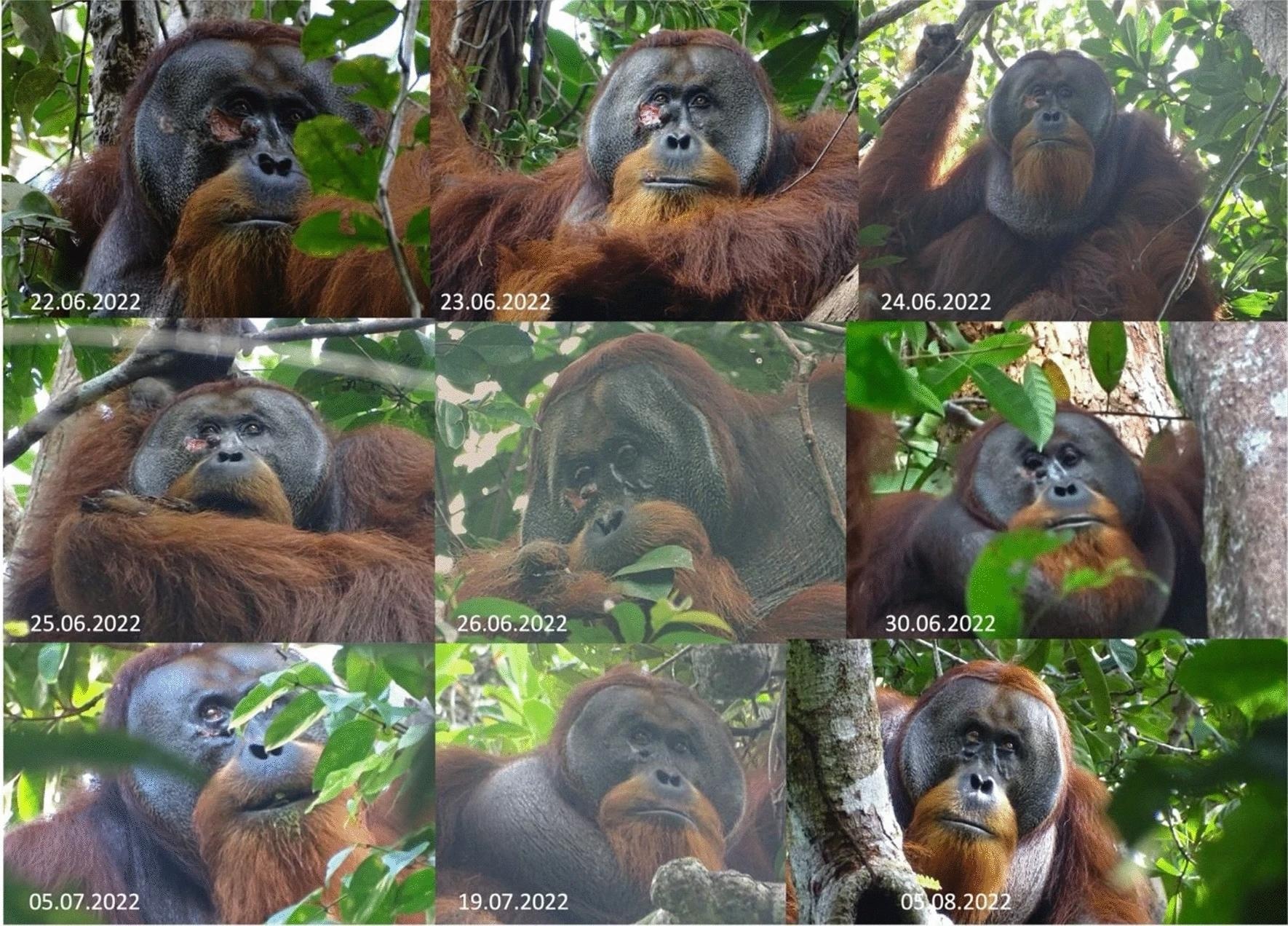In a recent study published in the journal Scientific Reports, a group of researchers documented the first observed instance of a wild Sumatran orangutan (Pongo abelii) actively treating a facial wound with a medicinal plant, offering insights into the origins of human wound care.
Process of wound healing. Rakus fed on and later applied the masticated leaves of Fibraurea tinctoria to his facial wound on June 25. On June 26 he was again observed feeding on Fibraurea tinctoria leaves (see photo). By June 30 the wound was closed and by August 25 was barely visible anymore. Research Paper: Active self-treatment of a facial wound with a biologically active plant by a male Sumatran orangutan
Background
In the early 1960s, Jane Goodall discovered whole leaves in chimpanzee feces in Tanzania, identifying a behavior now known as whole leaf swallowing, which has anti-parasitic benefits. Along with others like bitter pith chewing, this behavior falls into five self-medication categories: sick behaviors, avoidance of contaminants, prophylactic consumption, therapeutic ingestion of bioactive substances, and therapeutic topical applications. While frequently observed in African apes, such behaviors are rarer in Asian apes, with notable exceptions like a juvenile Bornean orangutan consuming medicinal ginger. Further research is needed to explore the prevalence and efficacy of self-medication behaviors in non-human animals, as current evidence is limited and often anecdotal, requiring systematic study to understand these practices fully.
About the study
The present research observations were conducted in the Suaq Balimbing area within Gunung Leuser National Park, South Aceh, Indonesia. The subject of this study, a male Sumatran orangutan named Rakus, was first observed in March 2009 as an unflanged male viz adult but without secondary sexual characteristics and is believed to have been born in the late 1980s.
Data collection involved all-day focal follows, beginning when an orangutan left its night nest and continuing until a new one was built in the evening. Observations were recorded every two minutes using standardized protocols, with all rare behaviors carefully noted. Rakus was a focal subject for several days when a fresh wound was first noticed and subsequently when he treated this wound on June 25, 2022. Unfortunately, no visual records of the wound treatment exist, but a detailed account was documented.
For plant identification, detailed photographs were taken for comparison with a picture-based herbarium created at the onset of the Suaq Balimbing studies in collaboration with the National Herbarium of Indonesia and the National University of Indonesia. All the research adhered to ethical standards was strictly observational, and complied with the legal and ethical requirements set by the Indonesian Ministry of Research and Technology.
 Left: Pictures of Fibraurea tinctoria leaves. The length of the leaves is between 15 to 17 cm. Right: Rakus feeding on Fibraurea tinctoria leaves (photo taken on June 26, the day after applying the plant mesh to the wound).
Left: Pictures of Fibraurea tinctoria leaves. The length of the leaves is between 15 to 17 cm. Right: Rakus feeding on Fibraurea tinctoria leaves (photo taken on June 26, the day after applying the plant mesh to the wound).
Study results
On June 22, 2022, the research team observed Rakus with a fresh wound on his right flange and inside his mouth, which became visible when he made a long call. It is suspected that the wound resulted from a fight with another flanged male, as there was vocal evidence of such an encounter earlier that day.
Three days later, on June 25, Rakus was seen consuming the stem and leaves of the liana (Fibraurea tinctoria), known locally as ‘Akar Kuning.’ Although this plant is part of the regular diet for orangutans in the area, it is infrequently eaten, comprising only 0.3% of all feeding observations. However, records show that 47 out of 132 studied orangutans have been seen consuming parts of this plant. During this specific observation, Rakus started chewing the leaves without swallowing, using his fingers to extract and apply the juice directly to his facial wound. This application was methodically repeated over seven minutes.
Shortly after, flies began to gather at the wound site, prompting Rakus to cover the area thoroughly with the chewed plant pulp, masking the red flesh with green leaf material. He continued this treatment for a total of 34 minutes. The following day, Rakus briefly resumed eating the liana for about two minutes. Subsequent observations showed no signs of infection, and by June 30, the wound had visibly closed. By July 19, it had fully healed, leaving only a faint scar.
Additionally, an increase in Rakus’s resting behavior following his injury was noted, which could contribute positively to his healing process. Growth hormone release, protein synthesis, and cell division, critical to healing, are enhanced during rest. Data collected showed that Rakus’s resting time increased significantly post-injury, from an average of 14.8% of his day to 33%, and then stabilized to 23.6% once the wound healed. This change was particularly notable immediately following the wound treatment, with resting times exceeding 50% on several days. This behavioral adaptation likely played a role in his swift and effective recovery.
Conclusions
To summarize, this study documents the first observed case of a great ape using a plant for active wound treatment. Rakus, a male Sumatran orangutan, applied the juice of Fibraurea tinctoria leaves to a facial wound and covered it with chewed leaf mash, suggesting intentional self-medication. Increased resting post-injury likely aided his healing. This behavior underscores the potential for self-medication among non-human species and provides insights into the evolutionary origins of wound care. Given its rarity and the social dynamics within the orangutan population, this behavior could offer valuable lessons on the natural emergence and social transmission of medicinal practices in wild apes.
Journal reference:
- Laumer, I.B., Rahman, A., Rahmaeti, T. et al. Active self-treatment of a facial wound with a biologically active plant by a male Sumatran orangutan. Sci Rep (2024), DOI- 10.1038/s41598-024-58988-7, https://www.nature.com/articles/s41598-024-58988-7
